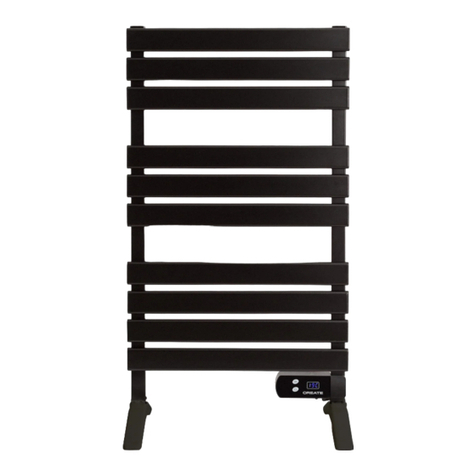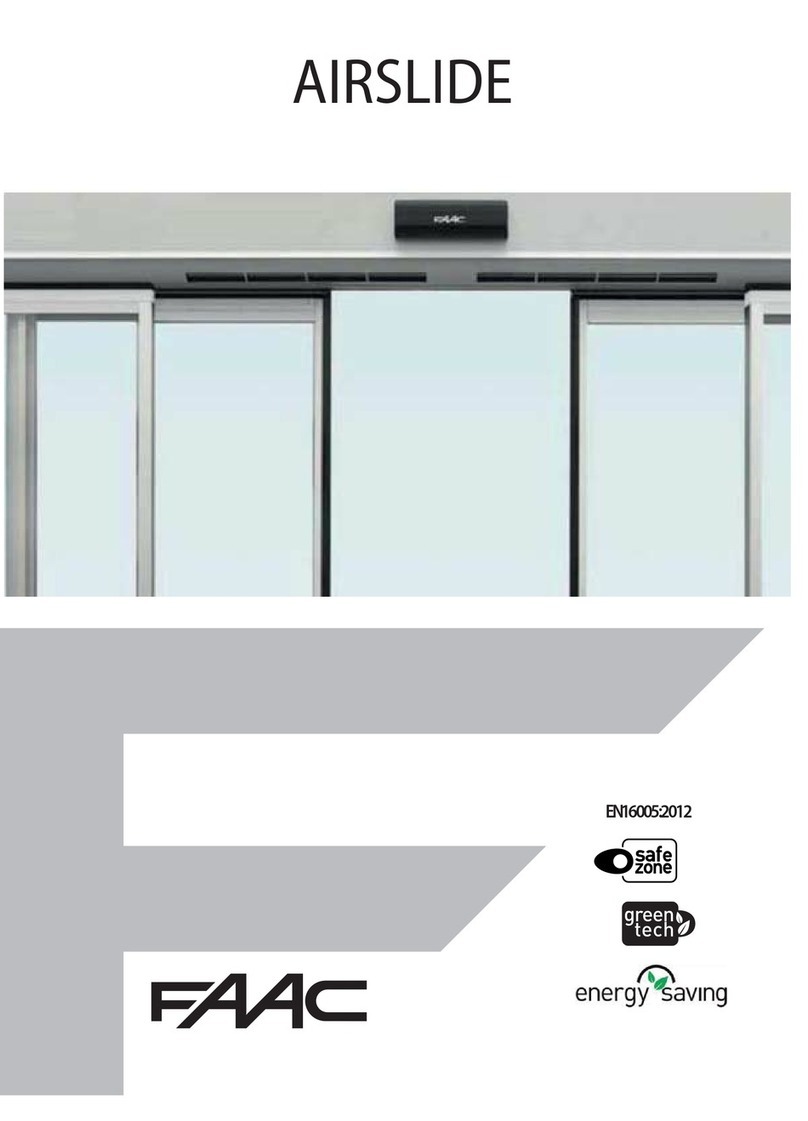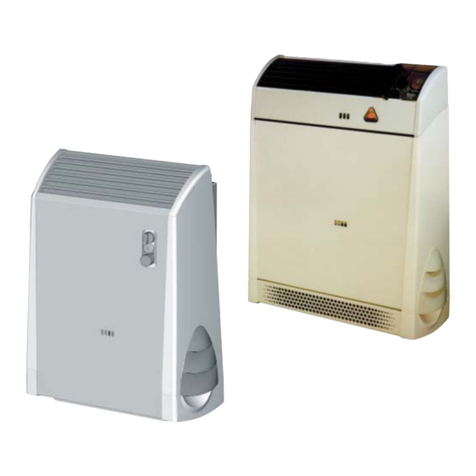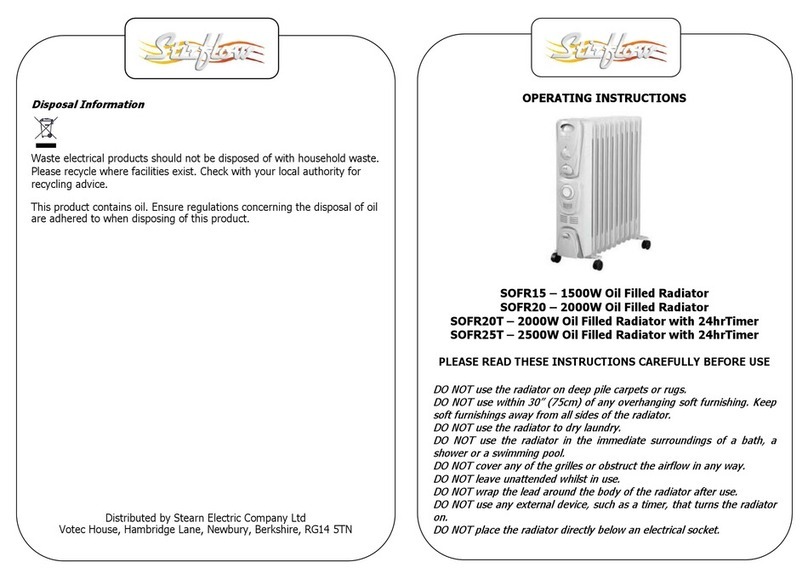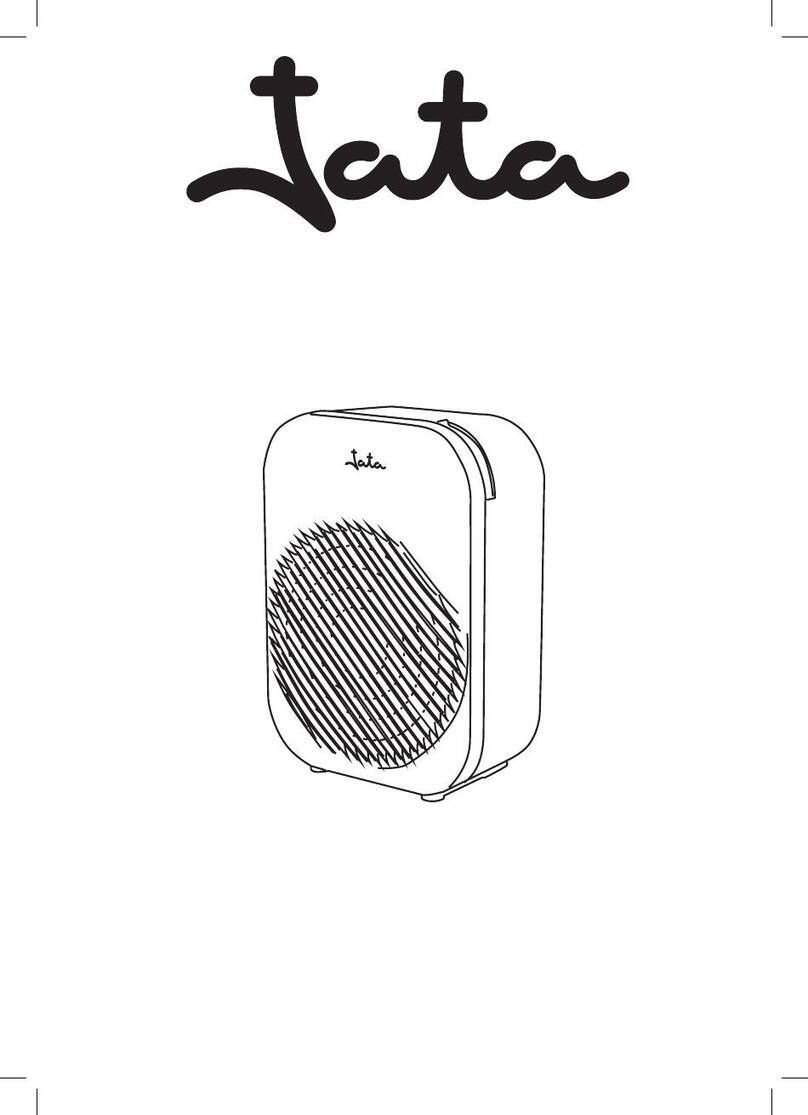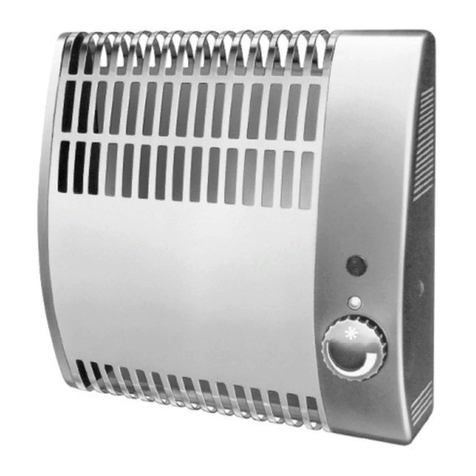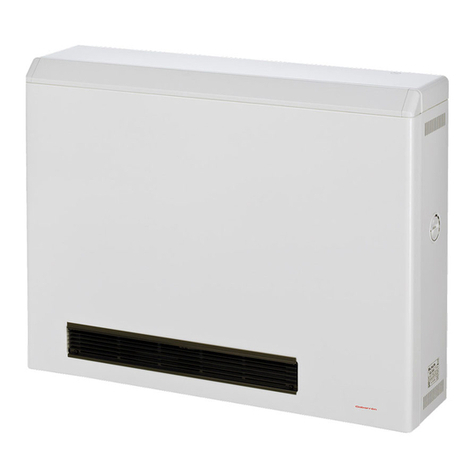Nibco RHP-1 User manual

Installation and Operation Manual Radiant Heat Panel
1
RHP-1&2 0511
NIBCO®Radiant Panel
Models RHP-1 & RHP-2

Installation and Operation Manual Radiant Heat Panel
2
RHP-1&2 0511
Table of Contents
Cover Page 1
Table of Contents 2
Warning Symbols 3
Safety Warnings 4
Definitions 5
Introduction 6
Specifications and Restrictions 7
Panel Picture with Parts Legend 8
RHP Schematic 9
Installation Instructions 10-12
Control Sequence 13-14
Component Descriptions 15
Specifications 16
Thermostat Instructions 17
3/4” TMV Instructions 18-19
1” TMV Instructions 20-23
Pump Instructions 24-28
General Terms and Warranty 29

Installation and Operation Manual Radiant Heat Panel
3
RHP-1&2 0511
Warning!
The following symbols are used throughout this document. For your safety please pay attention.
Treated Water,
Do Not Drink
When used with a boiler, fluid in
panel is typical
of fluids found in boilers.
Not for human consumption or for
washing, cleaning or as a dilution
fluid.
Warning
Pay Attention, Health Hazard
Do Not Take Risks
Possible Dangers
If In Doubt, Contact
NIBCO INC.
Danger
Live Power
24 Volt and 110 Volt
Qualified Electrician Only
Do Not Touch
Danger
Explosion
Electrical sparks could
cause explosion.
Do not operate near
flammable substances
such as, but not
limited to:
Gas, Oils, Propane,
Solvents, Paints,
etc.
Do Not Touch
Hot Pipes, Corrosive Liquids
Scalding is Possible
Corrosive
High or Low pH
Do not store corrosives
near this panel
Safety First -
Always!
NIBCO shall not be responsible for errors in catalogs, brochures or printed materials. NIBCO reserves the right to alter its
products at any time without notice. All trademarks are property of the respective companies. NIBCO®PEX is a trademark
of NIBCO INC. All Rights Reserved.

Installation and Operation Manual Radiant Heat Panel
4
RHP-1&2 0511
Warning!
Safety First -
Always!
This product must be installed, used, stored and operated strictly in accordance with the terms set
out in this manual and in accordance with all laws, rules, codes and regulations of the jurisdiction
wherein the product is located. Failure to follow the terms set out in this manual, or the foregoing
laws, rules, codes or regulations may result in property damage, serious injury or death.
In the event this product is not installed by a qualified person, as defined herein, or in the event this
product is not installed, used, stored or operated in accordance with the terms set out in this manual
or in accordance with all laws, rules, codes or regulations of the jurisdiction wherein the product is
located, or in the event this product is repaired or altered without the written consent of NIBCO, any
and all warranties offered by NIBCO in relation to this product will be void, and NIBCO will not
be responsible for any direct or indirect damage to this product or to any other property, personal
injury, and/or death, regardless of whether NIBCO advised of the possibility of such damage, injury
or death.
WARNING SYMBOLS:
This panel contains electrical devices which could ignite flammable vapors. Do not connect power to,
nor operate this equipment in the presence of flammable vapors.
The heated fluid supplied to this panel could be hot enough to cause personal injury should skin
remain in contact with pipes. Do not mount this panel in any area or manner which could lead to
injury. Treat like any other boiler room equipment. Keep children away.
The power to be connected to this panel has dangerous capabilities with potential to cause fatal
injury. The capability to injure continues to exist whether the power is on or off. No persons should
attempt to connect, service, repair or alter this equipment. Only a competent electrician, qualified by
local jurisdictions having authority should connect power to the panel. It is the responsibility of the
person installing this equipment to provide proper grounding.
Improper handling and installation of this product may cause equipment failure, serious injury or
death. Follow this manual, National Electrical and Plumbing Codes and Local Codes.
Motors and valves mounted on this panel require continuous air circulation. Overheated equipment
will lead to premature failure.
This panel does not come with pressure control equipment such as a pressure relief valve or expan-
sion tank. This panel is only to be connected to a heating plant which contains safety devices.
Do not use petroleum based products in or on this panel. Damage to seals can occur resulting in
personal and/or property damage.
This product is not protected from freezing. In applications where freeze protection is required, use
antifreeze solutions suitable for hydronic systems such as 50/50 mixture of propylene glycol and
water. Installing contractor to meet all local environmental and plumbing codes governing backflow
prevention. With Glycol, use a stabilized type, a separate stabilizer, or change fluids annually to
avoid a buildup of corrosive glycolic acid. See note on Page 7.
Brass products such as the valves supplied with this product are adversely affected by media that
contain - or that during the process of treatment could develop, agents aggressive to brass. This could
include Ammonia, Mercury, Oxygen, Carbon Dioxide, and Chloride. Further, the pH-value of the
fluid in the hydronic heating system in contact with the brass products should not exceed 9.5 .
Neglecting the above restrictions may in some circumstances cause damage to the brass in the panel
allowing the heating fluid to escape, possibly causing damage to property and/or persons.

Installation and Operation Manual Radiant Heat Panel
5
RHP-1&2 0511
Definitions
ASTM
ASHRAE
American Society for Testing and Materials
American Society of Heating, Refrigeration and Air-Conditioning Engineers
BTU British thermal unit. A unit of measuring the amount of energy required to raise one pound of
water by 1°F.
Btuh British thermal unit per hour. The rate at which energy is transferred.
Circuit
CSA
Pipe that is connected from supply manifold to the return manifold.
Canadian Standards Assosiation
Design
Temperature
The temperature of the system needed to be maintained under extreme outside
temperature conditions.
Zone Area with one or more loops controlled by single thermostat.
RFH Radiant Floor Heating
Thermostatic
Control An internal mechanical element which reacts to temperature changes.
RHP NIBCO®PEX Radiant Heat Systems Panel Model RHP
USgpm Gallons (US) per minute of liquid flow.
UL Underwriter’s Laboratory
Thermostatic Non electrical temperature control
Heat Source A source of heated fluid for the RHP. This could be electric, gas, or wood-fired heat from a
boiler or water heater.
Loop Single piece of PEX pipe connected to a manifold.

Installation and Operation Manual Radiant Heat Panel
6
RHP-1&2 0511
Thank you for purchasing a NIBCO®Radiant Heat Panel. The RHP unit is the easiest way to link a
properly sized heat source to the radiant system using time tested control technology. Backed by years
of experience designing components for the heating industry, the NIBCO®RHP is a reliable choice
for radiant system control.
Features: Benefits:
Pre-engineered Designed for Dependable Performance using Proven Components
Pre-assembled Tested for Installation Leak Free Consistency.
Pre-wired Facilitates Quick Trouble Free Start Ups.
Compact Minimal area needed for installation.
Modular Systems of any size can be assembled.
Warranty 12 months from purchase.
The RHP-1 model will serve up to five loops. The RHP-2 model will serve up to ten loops.
Each loop is capable of handling no more than 0.5 USgpm.
Each loop is to be ½” PEX (or BARRIER-PEX).
Each loop is not to exceed 250 ft.
The RHP moves heated fluid to the Radiant Floor Heating (RFH) system and allow you to raise or lower
the room temperature. As long as the circulator is moving water according to instructions from the
thermostat, the RHP is operating as intended.
The delivery of heat to your floor and room is based on the temperature of the fluid, the capacity of
the RHP circulator and design of the RFH. Restriction to water flow such as the radiant floor heating
pipes in your floor, temperature of the heated water, and the design/installation of your RFH system
will have an impact on the system. Most RFH systems need a minimum of 110oF water to work prop-
erly, while some need temperatures of 150 oF.
The proper design of a RFH system will make the difference between your satisfaction or
dissatisfaction. Several factors such as slab insulation, tube length, spacing, floor covering and heat loss
will affect the performance of your system. The RHP has no control over these important factors.
The RHP simply moves the heated water to the RFH(s) based on instructions from the thermostat. There
is no need to modify, cut, change, or otherwise alter the RHP. Doing so will void warranty.
Introduction
Introduction
Features/Benefits
Capacity
Function
Performance
Expectations
Disclaimer NIBCO shall not be responsible for any errors in catalogs, brochures or printed materials. NIBCO
reserves the right to alter its products at any time without notice. NIBCO®PEX is a trademark of
NIBCO INC. All Rights Reserved.

Installation and Operation Manual Radiant Heat Panel
7
RHP-1&2 0511
Specifications & Restrictions
Circulators
Material Properties
of Components
The parts used on the RHP are composed of non-ferous material. The types of materials used that
are in contact with water are brass, TP 304/TP 304L stainless steel, and EPDM rubber.
The NIBCO®RHP is pre-assembled and pre-wired using our standard products. The circulator has
been selected to handle the flow requirements for a typical system plus a marginal allowance for any
additional pressure capacity not considered. The circulator will be undersized if there are more than
the maximum loops, if the loops are longer than 250 ft. or if they are smaller than 1/2” in diameter.
Manifold Connections
Boiler vs. Domestic
Water Heaters
The RHP-1 is designed for 3/4” PEX piping to and from the heat source and to and from the distri-
bution manifold. The RHP-2 is designed for 1” PEX piping.
Any heat source such as a domestic water heater, cast iron boiler, outside wood
furnace or other heat source is compatible with this RHP.
NOTE: The circulators supplied with the RHP are suitable for potable ap-
plications. If any type of glycol is used in the system, it must be isolated
from domestic water use. Propylene glycol is posionous and ethylene
glycol is toxic. Follow codes and standards of authorities having jurisdic-
tion. With Glycol, use a stabilized glycol, a separate stabilizer, or change
fluids annually to avoid a buildup of corrosive glycolic acid.
Pressure losses have been dimensioned based on design flows through ½” nominal PEX tubing at
a rate of 0.5 to 0.7 USgpm. A nominal 9 ft. of head for the radiant tubing and 4 ft. of head for
control valves, pipe and fittings has been allowed for in the circulator selection.
If system requires a larger circulator, you should consider a modular approach and use multiple
RHP’s. Mixing valves have been selected to provide sufficient flow for a minimum and maximum
case.
The RHP utilizes an electronic thermostat, which is placed within the room where temperature is
monitored by an internal room sensor.
Control Format
Hydraulics

Installation and Operation Manual Radiant Heat Panel
8
RHP-1&2 0511
Parts Legend :
1. Thermostat
2. Pump
3. Power Box with transformer, relay and integral timer
4. Temperature Gauge
5. Mixing Valve
6. Thermostat jack and auxiliary contacts
The room thermostat is the controller that signals the circulator and has an internal air sensor
which monitors the temperature. Some thermostats include a limitation sensor which should be in a
protective sleeve (such as a short piece of PEX) when placed in a slab. If your thermostat has a floor
sensor, you have two options when controlling temperature. One option is to use the floor sensor to
ensure the set maximum temperature is not exceeded. The second option uses the sensor to keep a
constant set temperature in the floor. For either option when there is a call for heat the thermostat
signals the circulator which causes heated fluid to enter the radiant system.
NIBCO®Radiant Panel Model RHP-1
Room Temperature
Control
<<< (Hs) Heat Source
>>> (Hr) Return to Heat
This is a representative panel. Your model may differ slightly.
RHP-2 Panel is very similar but utilizes 1” TMV instead of 3/4”.
Return from Floor >>>
Supply to Floor <<<
5
4
3
2
1
6

Installation and Operation Manual Radiant Heat Panel
9
RHP-1&2 0511
RHP Schematic #1
Model Shown: RHP-1
Description: Shown with 4
Loop Manifold and 3 Loops,
Closed system .
Water heater shown is a
representative model.
PEX Pipe

Installation and Operation Manual Radiant Heat Panel
10
RHP-1&2 0511
Examine carton for visible damage that may have occured during shipping. If damage is
visible notify your courier and supplier immediately.
Open carton carefully, pull tape off carton, do not cut tape or you may damage the finish on
the panel.
Remove the panel from the carton, lift panel by base, and do not lift by circulator or other
components.
Locate and verify that the items shown below are packaged in the carton or in the panel.
Before discarding carton, check carefully for any loose components or accessories that may
be located in the box.
It is recommended the piping distance between the RHP and the heater should be no greater
than 20ft. and central to RFH manifolds. In addition, the components on the RHP must be easily
accessible should repair or service be required.
Give careful consideration to the mounting location of your RHP panel. You must ensure you
have adequate room to connect the heat source supply and return as well as the system
supply and return to the panel. To minimize piping, locate the panel as close as possible to the
heat source (max. 20 ft.). The electrical feed into the panel is through a 6 foot factory wired cord
and plug that requires a dedicated 15-amp receptacle. Locate the panel near the receptacle
or in an area where such a receptacle can be easily installed.
Dimension lines are to a pipe velocity between 2 and 5 ft/s. (see chart below). The circulator
supplied with the RHP has differential pressure available for some limited distribution piping.
Exceeding the available differential pressure could cause under-performance. Please refer to
specification sheet or contact NIBCO.
1. Unpacking
2. Location of Panel
Installation Instructions
3. Distribution Pipe

Installation and Operation Manual Radiant Heat Panel
11
RHP-1&2 0511
Use 3/4” PEX or 3/4” copper (use 1” on RHP-2) to connect from the RHP panel
to the manifolds and from the panel to the heat source (page 9).
Panel connections consist of a union nut, washer, and a FPT adapter. These
components must be used on every installation. System connections will consist of
a 3/4” MPT x PEX adapter or 3/4” MPT x copper adapter, depending on the
material used (the adapters will be 1” on RHP-2).
Follow these steps and refer to picture below.
Screw 3/4” FIP adapter (D)(supplied with panel) into adapter (E) or (H) using appropriate
thread sealant.
Without disturbing gasket (C) place assembly against flanged steel pipe (A)
Slide nut (B) over adapter (D) and finger tighten.
Use 2, 30mm or adjustable wrenches. Attach 1 to adapter (D) and hold it firmly in place.
Attach other wrench to union nut (B) and tighten 1/4 turn.
Pipe Connections
Step 1
Step 2
Step 3
Step 4
A - Flanged pipe on panel
B - Nut on panel
C - Rubber gasket
D - 3/4” FIP adapter
E - PEX x Male thread adapter
F - Copper crimp ring (SS clamp or SS sleeve)
G - 3/4” PEX
Installation Instructions

Installation and Operation Manual Radiant Heat Panel
12
RHP-1&2 0511
It is required to install an in-line expansion tank in the supply from heat source. This allows for
contraction and expansion of the fluid.
The objective in filling the RHP and related equipment is to purge air from the piping network.
To allow proper filling and purging, it is necessary to install fill and purge valves as seen in the
example schematic on page 9. The fill and purge valves are not included with the RHP. Allow suf-
ficient time and flow for air bubbles to be flushed from the system. An air eliminator (not included)
will facilitate the final purging of air. The RHP has no ability to deal with air locks, which impede
the performance of the system and can cause the pump to fail. Installer will need two hoses to
complete the following procedure. Hoses must each have a female connection to attach to ap-
propriate valves. (Installer takes responsibility and liability to meet all local environmental codes
for discharging fluids).
Purging Instructions
1. Turn off power to RHP and fill heat source with fluid. Open all isolation and drain valves
(except the one between the fill and purge valves).
2. Close all individual loop isolation (balancing) valves on manifold except one. Connect hose to
water source outlet and the other end to fill valve. Connect another hose to purge valve and to a
suitable discharge (such as a large bucket) and begin filling. Flow will be in reverse of normal.
3. When flow appears free of air bubbles, close the open loop and move to the next loop - thus
filling and purging each loop in turn.
Note:
If using a glycol mix, pump in the mix from a large container and purge back into the same con-
tainer.
Locate room thermostat. Use a suitable 3 conductor wire and connect the N,L, and Signal terminals
on the thermostat to the corresponding terminals on the RHP wiring block. The room thermostat
should be located in an area representative of the most commonly used space, between 50 and
60 inches above the floor, away from doors, curtains, draughts, direct sunlight, air registers, fire-
places, or any other form of heat, which may influence the control.
If you desire to use the RHP to signal a boiler to fire, use the auxilary contacts. This pair may be
connected to a boiler and the circuit will close when heat is called for by the panel.
Finally, connect 110V power to RHP.
To reduce heat transfer from RHP to room, insulate with standard grade pipe insulation. Do not
insulate electric motors.
8. Fill and Purge
Installation Instructions
9. Wiring
Running the circulator
dry voids
warranty. Ensure the
system is filled
before operating the
circulator.
10. Pipe Insulation

Installation and Operation Manual Radiant Heat Panel
13
RHP-1&2 0511
Control Notes
Control Sequence
The RHP does not control the heat source (however see note at bottom of page 11)
The heat source requires its own control system, according to local codes independent of the RHP.
1. When room thermostat calls for heat the dry contacts in the thermostat are closed.
2. The radiant circulator will begin to pump heated fluid to the system.
3. For the RHP-1 and RHP-2 models, the limitation sensor (if in use) monitors the temperature of the
floor to ensure the maximum temperature is not exceeded or the target temperature is maintained.
4. When the room temperature is met, the dry contact opens which turns the radiant circulator off.
Control Sequence
Field Setting of the
Limitation Sensor
Thermostat for the
RHP-1 and RHP-2
Models.
Some thermostats include a floor sensor. If in use, there are two available options when setting the
limitation sensor. From the factory, the thermostat is set not to utilize the floor sensor.
Option 1 - Allows the use of the sensor as a limitation to the maximum temperature allowed for
the floor. For example, the placement of the limitation sensor in a radiant wooden floor. Typically
the floor should be under 85oF. With the limitation sensor set to the first option (maximum sensor),
a temperature reading above 85oF will cause the thermostat to close the actuator ensuring an over-
shoot will not occur.
Option 2 - Which can be chosen uses the limitation sensor as a temperature set point. With this
setting a particular temperature can be set for the floor, which the thermostat will maintain. For
example, the floor in the bathroom might requires a constant temperature of 80oF for comfort. All
one has to do is adjust the temperature in the thermostat to the 80oFand the limitation sensor will
maintain the desired set temperature.
To adjust the temperature setting of the sensor or to change from one option to another, it is neces-
sary first to open the thermostat cover. Second, gently pry out the inside cover.
The switch on the bottom left of the thermostat has two sections. The top portion, labelled “MAX”,
allows setting of the thermostat as a limit switch. This corresponds to option one above i.e. limiting
the temperature under a wood floor. The white portion of the scale, labelled “MIN”, allows settting
of the thermostat as a minimum set point. This corresponds to option two above i.e. setting the
minimum floor temperature of a bathroom ceramic floor.
The blue square in the upper right hand corner has an slot for turning with a screwdriver and an indi-
cator arrow pointing to a series of temperature settings. Refer to page 17 for instructions.
Field Setting of
the Mixing Valve
for the RHP-1 and
RHP-2 Models.
The Thermostatic Mixing Valve (“TMV”) mixes hot water from the heat source and return water from
the floor. This enables tempering of the hot water supplied to the floor and the return water going
back to the heat source. This is particularly important when utilizing a boiler or with a wooden floor.
Please consult your boiler manufacturer or installer to determine the correct return water temperature
for your heat source.

Installation and Operation Manual Radiant Heat Panel
14
RHP-1&2 0511
An example: Your supply temperature is 140 degrees F and your target return temperature is 100
degrees F. (100 - 50) / 10 = 5 and 100 + 5 = 105. Referring to the chart yields a TMV dial
setting just below 2.
Timer for the RHP-1
and RHP-2 Models
The TMV has six settings which are changed by turning the knob under the square cover on top of the
TMV on the RHP 1, the RHP-2 does not have a cover. Remove the cover by prising against the small
tab on either side. In order to adjust the TMV to the proper setting, determine the supply temperature
to the RHP and the desired return temperature. [Some boilers require a minimum return temperature
to protect against flue gas condensation, consult your boiler provider if applicable] Subtract 50 from
the return temperature and divide by 10. Add this number to the return temperature to determine the
target temperature as seen on page 18 (RHP-1) and page 20 (RHP-2)
Start Up 1. Set thermostat(s) 5 to 10 degrees above actual room temperature.
2. If a floor sensor is used make sure the minimum setting (if used) is at least
5 to 10 degrees higher than the actual floor temperature.
3. If you are using the auxilary contacts to bring on the heat source, make sure
they are connected.
4. Plug power cord into a 110V outlet.
5. Observe the panel to ensure it follows the proper sequence of operation.
6. After the system temperature stabilizes, verify mixed fluid temperature
is within a few degrees of the desired set point by checking with a temperature
gauge. If the temperature is off, re-adjust the 3 way thermostatic valve.
The integral timer’s purpose is to circulate water for a short period each day within the system.
If you are employing an open system (sharing the heat source with domestic uses) this prevents
any “stale” water from accumulating in the pipes during the summer period. The timer will activate the
system for 15 minutes every 24 hours. You should leave the panel turned on with the thermostat
turned down even in the summer to allow the timer to activate this circulation. If you are operating
a closed system, you may turn the panel off in summer or even disconnect the power cord.

Installation and Operation Manual Radiant Heat Panel
15
RHP-1&2 0511
Thermostat
Type: RHP-1 &
RHP-2:Danfoss FH-WS
PX
Description/Function:
The Danfoss thermostat is designed to be flush mounted.
It has an adjustable limit sensor which can be set to
maintain a minimum floor temperature or to protect the
floor via a maximum temperature setting. Please refer to
the instruction sheet that comes with the thermostat.
Specifications:
• Temperature range 50 -86oF
• 24V AC, 60Hz
• Dry Contact, Max 2A
• Fully electronic
• LED status indicator
1
Mixing Valve
Type: TMV
Model: RHP-1:
065B8876
PX10292
Description/Function:
The TMV (Thermostatic Mixing Valve) is
a 3-way brass valve which regulates the
temperature in the radiant system.
Specifications:
• Maximum flow temperature 180°F
• 3/4” BSPP
• Maximum working pressure 145 psi
5
Type: TMV
Model: RHP-2
065B8999CA
PX10293
Description/Function:
The TMV (Thermostatic Mixing Valve) is
a 3-way brass valve which regulates the
temperature in the radiant system.
Specifications:
• Maximum flow temperature 180°F
• 1” BSPP
• Maximum working pressure 145 psi

Installation and Operation Manual Radiant Heat Panel
16
RHP-1&2 0511
Specifications
6 Amp Inductive Load
Transformer
110 Volt Circulators
Single Zone 0.9 L
Dry: 10lb (4.5kg)
Filled: 15lb (6.5kg)
136 BTU/hr @120 °F AWT
205 BTU/hr @140 °F AWT
280 BTU/hr @160 °F AWT
Control Valves**
TMV: Brass body.
Ball Valves
Hose bib/ Pet cock: Brass body, PTFE, FKM, EPDM rubber seals
Circulator
Standard Models Grundfos: PES composite,Composite Pump Housing, EP Rubber
Piping
Type TP304/TP304L Stainless
180°F
125 psi
180°F
Electrical Specifications
Weights
(RHP-1)
Thermal Output
to Room
(RHP-1)
Materials in Contact
with Water
Maximum Ambient
Temperature
Maximum Operating
Pressure
Maximum Operating
Temperature
Volume

Installation and Operation Manual Radiant Heat Panel
17
RHP-1&2 0511

Installation and Operation Manual Radiant Heat Panel
18
RHP-1&2 0511
Index
Applications
The Series 30 is a multi-purpose thermostatic mixing valve
designed for ease of installation and a wide variety of uses.
The TMV offers accurate temperature control via a self-regulating
thermostat. The valves are designed to control temperature of
Domestic Hot Water (DHW), Hydronic Radiant Space Heating,
Heat Pump, and Solar Systems for central mixing applications.
Series 30 MR offer the following features:
• Anti-scald function* (see below).
• Listed to meet ASSE 1017 requirements (applies to 85–120°F
and 95–140°F only).
• Purpose: Mixing function.
• Temperature Ranges: 70–110°F (20–43°C),
85–120°F (29–49°C), or 95–140°F (35–60°C).
• Maximum working pressure: 150psi (10 bar).
• Maximum hot water inlet temperature: 194°F (90°C).
• Maximum pressure difference between hot and cold supply:
20% to max. 44psi (3 bar).
• Minimum flow requirement: 0.5USgpm (113.5l/hr).
• Designed for long-life and easy maintenance.
• Minimal outlet temperature fluctuation.
VERY IMPORTANT!
To the Installer:
These installation and maintenance instructions
must be reviewed by all installers and by the owners
of the building or property where the device will
be installed.
* The Serie 30 is designed to respond to a failure of the cold
water supply by a complete closing of the hot water supply port
before the outlet temperature exceeds the setting by 18°F (10°C).
NOTE: To ensure that the anti-scald function works properly, the
pressure difference between inlets and outlet should not exceed
72 psi (5 bar), otherwise minor leakage could occur.
Setting
The Series 30 MR temperature setting is accomplished by
adjusting the setting wheel between 1 and 6 to obtain the
required mixed water temperature. For quick setting refer to the
table below. Series 30 MR valves are not factory calibrated.
For accurate setting, measure the mixed water temperature once
hot and cold supply temperatures are stabilized. Adjust setting as
required to obtain the desired temperature.
Installation
To protect the TMV from excessive heat, and avoid voiding the
warranty, the tailpieces must be soldered before attaching them to
the TMV (see below). Gaskets supplied must be installed as shown.
NOTE: When installing a TMV on plumbing systems using CPVC
piping, always follow the pipe manufacturer’s instructions.
1. Position union nut
over tailpiece
before soldering.
2. Solder tailpiece to
tubing.
3. Insert gasket in nut.
4. Connect to TMV.
Gasket
Adjust temperature setting
between 1–6.
Mount label on cap to seal
valve. Space is provided on the
label to indicate measured
outlet temperature, date and
signature of installer.
Coppertubing
TMV
Solder joint
Installation and Maintenance InstructionsThermostatic Mixing Valve Series 30 MR
© Copyright. All rights reserved.
Over time the temperature setting
may have to be adjusted due to
scaling or dirt deposited in the
valve.
+
F
F
F
F
F
F
–
+
120°F 67 74 81 87 94 109 80 90 97 102 107 115 95 106 115 119 120 120
140°F 68 75 82 90 97 113 81 91 99 104 109 117 97 108 117 126 133 140
160°F 69 76 84 92 100 118 82 93 100 106 112 118 99 109 118 127 135 145
180°F 70 77 86 95 102 122 82 95 102 108 114 120 100 111 120 129 135 149
Hot water 70–110°F 85–120°F 95–140°F
Temperature 1 2 3 4 5 6 1 2 3 4 5 6 1 2 3 4 5 6
Note: Table is based on 50°F cold water and no difference between hot and cold water supply pressures. For other cold water temperatures correct the mixed
temperature by 1°F for every 10°F from 50°F, up or down.
Push pin to remove cap. Remove cap. Replace cap.

Installation and Operation Manual Radiant Heat Panel
19
RHP-1&2 0511
Installation continued
The Series 30 MR valves are not intended to provide final
temperature control at the fixtures or appliances. Use Series 30
HR/HV valves that meet ASSE 1016 for these applications.
The valve should be installed below the storage tank or water
heater as shown in Fig. 3 wherever possible. If the valve is
installed adjacent to, or higher than the storage tank or water
heater, it is important to prevent gravity circulation during times
where there is no consumption of water. This is done by various
methods such as a heat trap loop or a check valve in the cold
water feed line as shown in the examples below.
A check valve should also be installed whenever a high tempera-
ture (uncontrolled) water outlet is included (Fig. 4).
For installation of a TMV in a system providing recirculated
tempered water using a circulation pump refer to Fig. 6.
An aquastat to limit circulation of recirculated water is not
required with Series 30 MR/HR/HV valves.
3
54
21
7
Serie 30 MR
6
* Spare Parts
© Copyright. All rights reserved. Art. nr. 15323 · Ritn. nr. 9097-01 Utg. B
Inspection and maintenance –important!
To ensure proper function, a licensed contractor should verify the
mixed outlet temperature annually. The following maintenance
procedure should be performed each year and at times when
increase in water outlet temperature is observed. Replacement
of the valve insert may be required if maintenance and calibration
of the valve does not result in correct temperature readings.
To clean and/or restore the valve, shut off water and:
1. Remove cap (item 1) and note position of adjustment wheel.
2. Remove wheel and disassemble valve by removing adjustment
bonnet (item 2) and internal parts. (items 3–6).
3. Remove carefully all scaling (calcium deposits) or foreign
particles from all parts. Do not use sharp tools or scratch
surfaces. Regrease all internal components using silicon grease.
4. Assemble the valve and restore water supplies.
5. Calibrate by measuring the mixed outlet temperature.
6. Replace adjustment wheel and cap to prevent tampering.
7. Record service date and valve setting on valve label.
6 –Body
5 –Spring*
4 –Shuttle*
3 –Thermostat*
2 –Adjustment bonnet*
1 –Cap
Primary-Secondary Pumping
Central Mixing
Central Mixing Radiant Floor Heating Recirculated Domestic Water
Central Mixing Central Mixing
Boiler Return Water Temperature Control
Distributed by:
Danfoss Inc.
7880 Tranmere Drive
Mississauga, Ontario
Canada L5S 1L9
Tel. (905) 676-6000
Fax. (905) 676-0279
Distributed by:
Danfoss Comfort Controls
3435 Box Hill Corporate Center Drive
Suite C
Abingdon, Maryland
U.S.A. 21009
Tel. (443) 512-0266
Fax. (443) 512-0270
8

Installation and Operation Manual Radiant Heat Panel
20
RHP-1&2 0511
This manual suits for next models
1
Table of contents
Popular Heater manuals by other brands

Rinnai
Rinnai RHFE-556 FM Service manual

HORNEET
HORNEET HS0116 Instruction for operation and maintenance

Midea
Midea NDK20-21AF owner's manual
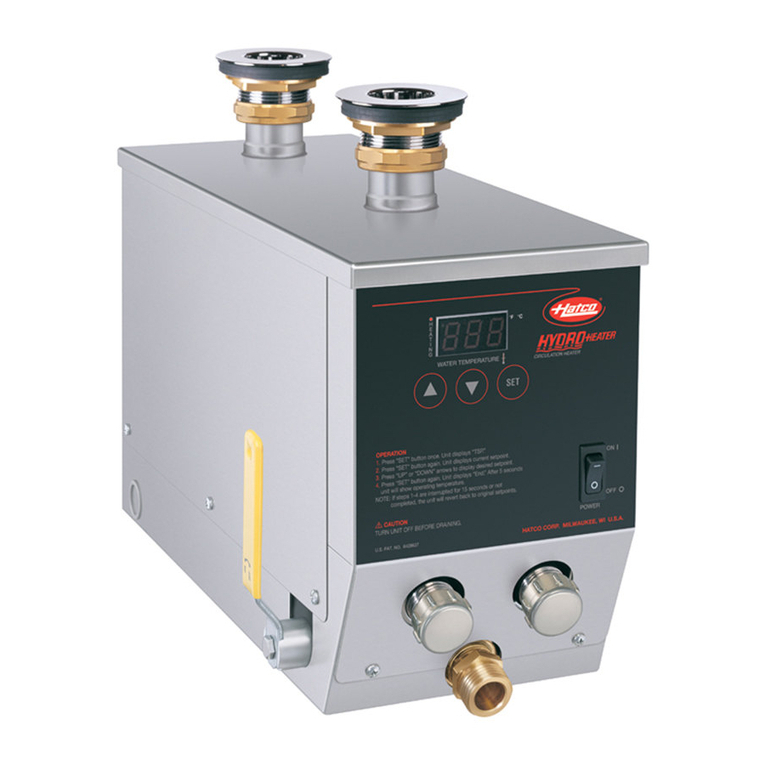
Hatco
Hatco HYDRO-HEATER 3CS2 Series Installation and operating manual
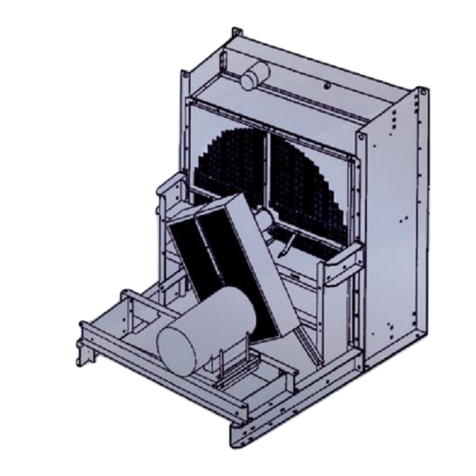
Kelvin
Kelvin ROCORE VB Series Installation, operation and maintenance manual

ORIGO
ORIGO FH-T20P instruction manual

